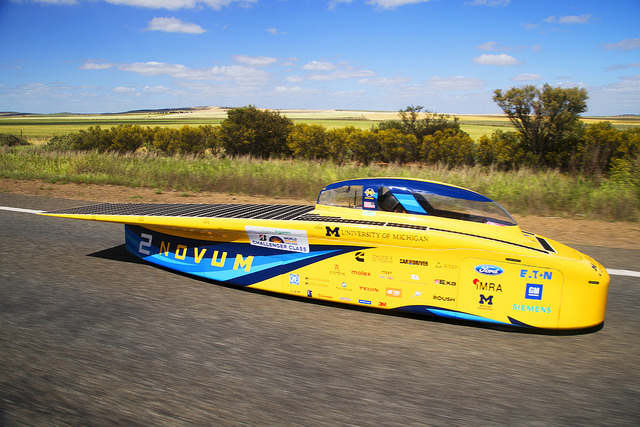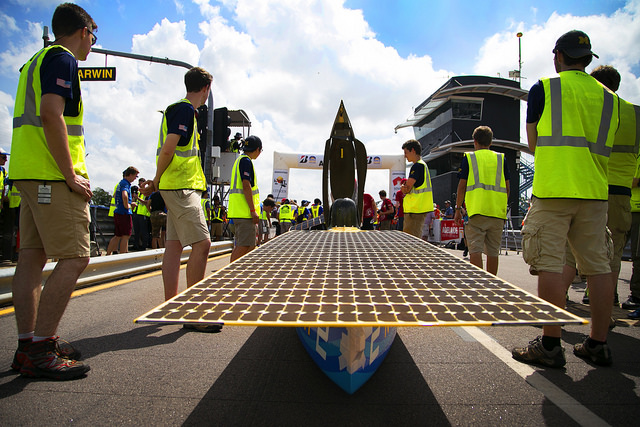
The University of Michigan’s Solar Car team hopes to beat its second place showing at the 2017 World Solar Challenge as it heads to the American Solar Challenge this July. Image Courtesy of Akhil Kantipuly, UM Solar Car Media Producer
May 24, 2018
Fresh off last October’s World Solar Challenge, the University of Michigan Solar Car Team is leveraging a steady diet of 3D design and simulation tools to fine tune the aerodynamics and power structures on its award-winning solar car, hoping to best its most recent second-place showing during the upcoming U.S. race.
The Michigan team’s entry for the American Solar Challenge, to be held in July in Nebraska, is the Novum, a completely redesigned vehicle with an unconventionally narrow monohull shape that is 43% narrower than the team’s last car and, according to simulation data, 20% more efficient. Novum made its official racing debut last October during the Bridgestone World Solar Challenge where it crossed a grueling 1,800-plus miles of Australian Outback terrain, taking second place—the best finish for a U.S. team. The upcoming U.S. race will take Novum on a 1,700-mile journey near the Oregon Trail, starting in Nebraska and finishing in Oregon.
 The University of Michigan’s Solar Car team hopes to beat its second place showing at the 2017 World Solar Challenge as it heads to the American Solar Challenge this July. Image Courtesy of Akhil Kantipuly, UM Solar Car Media Producer.
The University of Michigan’s Solar Car team hopes to beat its second place showing at the 2017 World Solar Challenge as it heads to the American Solar Challenge this July. Image Courtesy of Akhil Kantipuly, UM Solar Car Media Producer.Novum, which borrows from the Latin word for innovate and employs the UM ending (for University of Michigan), really captures the essence of what the team was trying to accomplish with the new design, according to Lynne Bekdash, business director for the team, who came up with the name. The goal, Bekdash explains, was to trade up the traditional approach of creating a large aerobody area to accommodate more solar arrays for a smaller, more aerodynamic shape while employing higher efficiency, space-grade solar structures to make up the difference.
“This hadn’t been done before in solar car racing, but the risk paid off,” she explains. “We innovated in a big way.”
Siemens PLM Software’ NX CAD platform and STAR-CCM+ CFD software were used extensively, both in the early design of the Novum solar car and more recently for subsequent iterations as the team preps for the vehicle’s second season and next major race. The mantra for Novum’s design, “Go big to go small,” meant the engineering team had to focus on aerodynamic gains to ensure it didn’t sacrifice performance with the smaller, albeit more powerful solar array area. “Our goal was to make a small, narrow car, but the primary challenge was the stability of a small car is always less than a wider car,” explains Chae Woo Lim, Novum’s engineering director. “To mitigate that, we spent time refining the vehicle dynamics to make sure it could handle the cross winds in the Australian Outback. We had to make sure the car was safe and stable.”
 High-efficiency, space-grade solar arrays are a major design element of the University of Michigan’s Novum solar car. Image Courtesy of Akhil Kantipuly, UM Solar Car Media Producer.
High-efficiency, space-grade solar arrays are a major design element of the University of Michigan’s Novum solar car. Image Courtesy of Akhil Kantipuly, UM Solar Car Media Producer.The ability to create shapes with G2 (curvature-radius) continuity using NX helped the aerodynamics team more easily establish continuous curvature in the design, avoiding sharp corners and forming smoother connections between objects. STAR-CCM+ was essential for the aerodynamics optimization work, saving the team significant time and money by reducing reliance on physical prototypes and wind tunnel testing, Lim says.
Since last October’s Australian race, the team has done modifications on Novum’s design to accommodate regulation changes, including the addition of metal roll cages, as well as other minor tweaks. “We redesigned the canopy part of the aerobody and various other aspects of the car so it still functions as intended with the addition of the roll cage,” he says. “We’ve done a lot of CAD work and a lot of STAR-CCM+ simulation to validate how good our aerodynamics performance is with the new addition.”
The opportunity to dive in and learn CAD and CFD software by doing has given Lim and the rest of his solar team colleagues a leg up with real-world engineering expertise, he says. In addition to teaching the crew the importance of a multidisciplinary design focus, participation on a university-level solar team gave Lim exposure to essential non-engineering business skills in areas like collaboration and communications.
“It has let me explore the field of engineering without being hindered by academic progress,” Lim says, explaining that he got access to CFD software freshman year while it’s not normally taught in the classroom until Junior year or later. Same for composites, which are typically not part of the under graduate engineering curriculum. “The solar team exposed me to interesting aspects of engineering that I could explore without taking classes,” he adds.
For more on how the Novum team leveraged CAD and simulation tools and prepped for the 2017 World Solar Car Challenge, check out this video:
Subscribe to our FREE magazine, FREE email newsletters or both!
About the Author
Beth Stackpole is a contributing editor to Digital Engineering. Send e-mail about this article to [email protected].
Follow DE





